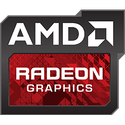8K Association Teases "World First" Showcase of 120 Hz 8K Gaming Experience - Enabled by AMD Hardware
The 8K Association was at the NAB 2025 Show with several areas of interest. At one end of the booth, there was a demonstration of real time gaming using an AMD-based gaming PC and a special 65" TV flown in from Korea by 8K Association member, Samsung, that supported 120 FPS display. The game was Horizon Forbidden West and the TV was a modified Neo QLED 8K display set enabled with the following features: Auto Low Latency Mode (ALLM), Variable Refresh Rate (VRR), and FreeSync Premium Pro. The PC was from MAINGEAR and used an AMD Ryzen 7 9800X3D CPU and an AMD Radeon RX 9070 XT GPU. The game supports the Steam platform which allows analytics to be shown and confirming the 120 Hz operation. The game was rendered at 5K and was then internally upscaled using AMD ML-based FidelityFX Super Resolution 3 technology.
The signal was sent to the TV using HDMI 2.1b with DSC support and the impressive smooth visuals attracted a lot of attention from visitors, especially those that were already aware of the game, which is visually very impressive. In the center of the booth was the latest 8KA "sizzle reel" which includes video provided by member company Imax featuring some impressive content scanned from its 70 mm film stock. BZBGear, another 8KA member was showing its range of switches, splitters and HDBaseT transmitters and receivers which all support 8K.
The signal was sent to the TV using HDMI 2.1b with DSC support and the impressive smooth visuals attracted a lot of attention from visitors, especially those that were already aware of the game, which is visually very impressive. In the center of the booth was the latest 8KA "sizzle reel" which includes video provided by member company Imax featuring some impressive content scanned from its 70 mm film stock. BZBGear, another 8KA member was showing its range of switches, splitters and HDBaseT transmitters and receivers which all support 8K.



















































